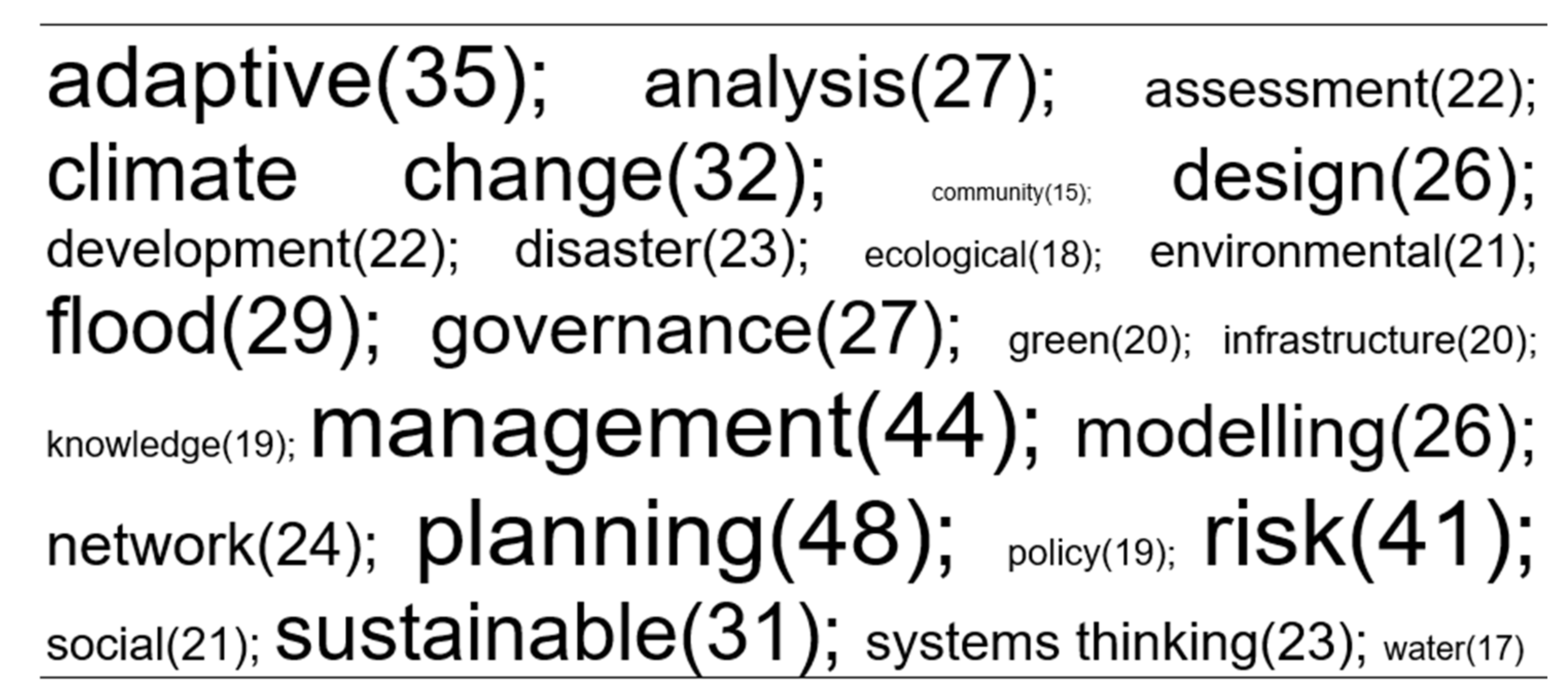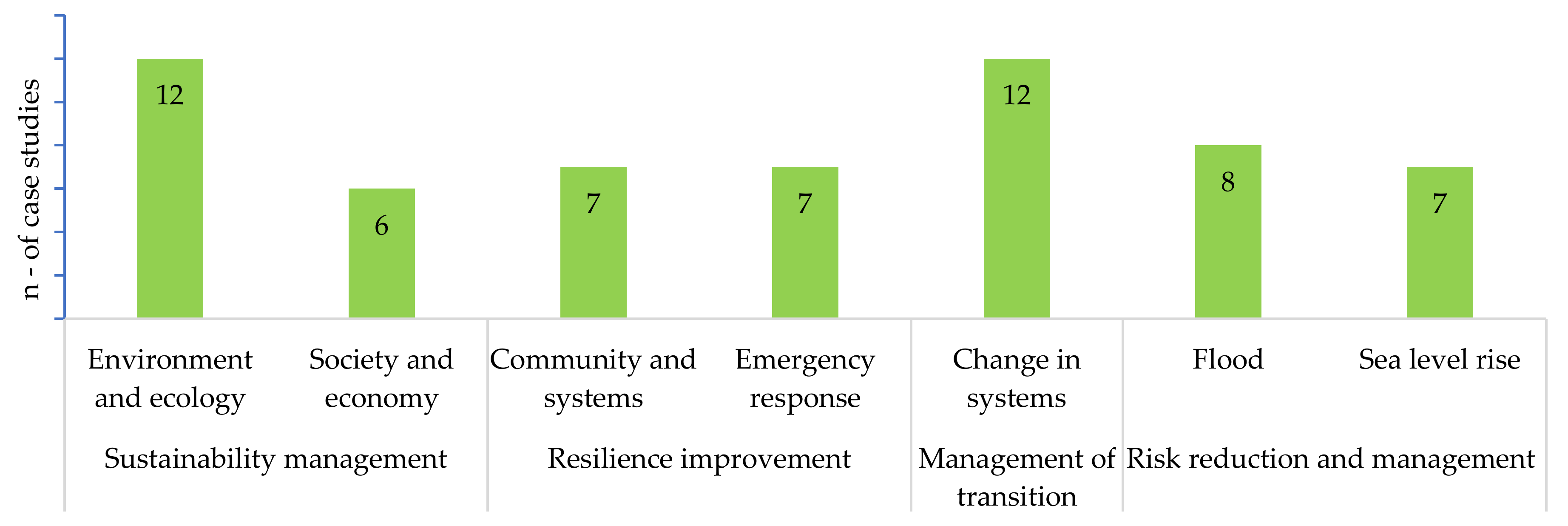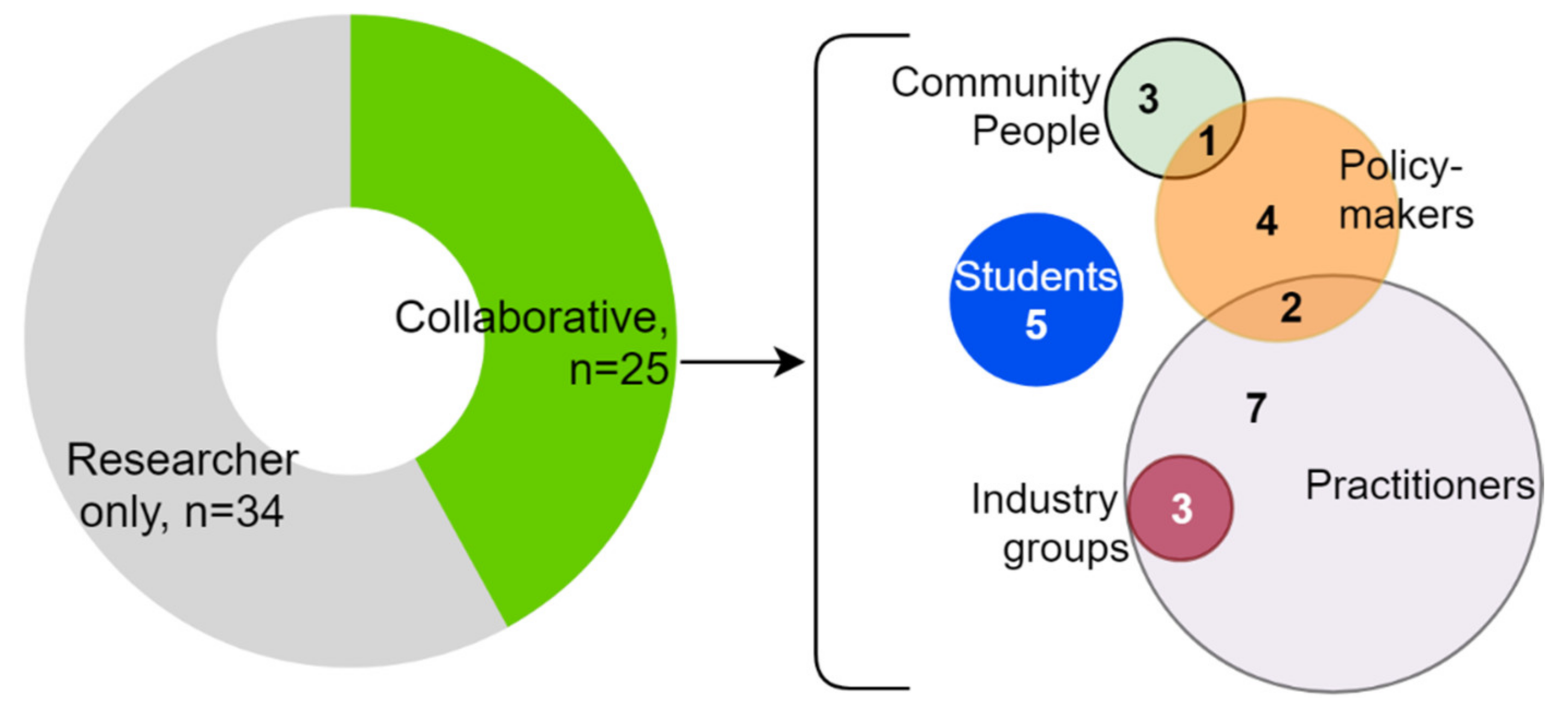Geodesign Approaches to City Resilience Planning: A Systematic Review
Abstract
:1. Introduction
1.1. Approach to the Resilience Planning
1.2. Geodesign as a Resilience Planning Approach
1.3. Research Questions
2. Materials and Method
2.1. Selection of the Geodesign Documents
2.2. Analysis Framework Development
2.3. Content Analysis and Document Clustering
3. Results
3.1. Key Resilience Terms
3.2. Content Analysis and Categorisation
3.3. Analysis of the Geodesign Case Studies
3.3.1. Overview of the Resilience-Related Applications
3.3.2. Context of Resilience Implementation (“Where”)
3.3.3. Approach and Tools Used (“How”)
3.3.4. Stakeholders Involved (“Who”)
4. Discussions
5. Conclusions
Supplementary Materials
Author Contributions
Funding
Acknowledgments
Conflicts of Interest
References
- United Nations. World Urbanization Prospects: The 2014 Revision, Highlights (ST/ESA/SER.A/352); Department of Economic and Social Affairs, Population Division: New York, NY, USA, 2014. [Google Scholar]
- Hanewinkel, M.; Arias, J.P.; Bronfman, N.C.; Cisternas, P.C.; Repetto, P.B. Hazard proximity and risk perception of tsunamis in coastal cities: Are people able to identify their risk? PLoS ONE 2017, 12, e0186455. [Google Scholar] [CrossRef] [Green Version]
- Jabareen, Y. Planning the resilient city: Concepts and strategies for coping with climate change and environmental risk. Cities 2013, 31, 220–229. [Google Scholar] [CrossRef]
- Peyroux, E. Discourse of Urban Resilience and ‘Inclusive Development’ in the Johannesburg Growth and Development Strategy 2040. Eur. J. Dev. Res. 2015, 27, 560–573. [Google Scholar] [CrossRef]
- Vale, L.J. The politics of resilient cities: Whose resilience and whose city? Build. Res. Inf. 2014, 42, 191–201. [Google Scholar] [CrossRef]
- Ahern, J. Urban landscape sustainability and resilience: The promise and challenges of integrating ecology with urban planning and design. Landsc. Ecol. 2013, 28, 1203–1212. [Google Scholar] [CrossRef]
- Pizzo, B. Problematizing resilience: Implications for planning theory and practice. Cities 2015, 43, 133–140. [Google Scholar] [CrossRef]
- Schipper, L.; Pelling, M. Disaster risk, climate change and international development: Scope for, and challenges to, integration. Disasters 2006, 30, 19–38. [Google Scholar] [CrossRef]
- Rockefeller Foundation; Arup. City Resilience Framework: City Resilience Index; Arup International Development: London, UK, 2014. [Google Scholar]
- Sanderson, D. Urban humanitarian response. In Good Practice Review 12; Overseas Development Institute: London, UK, 2019. [Google Scholar]
- Davoudi, S.; Shaw, K.; Haider, L.J.; Quinlan, A.E.; Peterson, G.D.; Wilkinson, C.; Fünfgeld, H.; McEvoy, D.; Porter, L.; Davoudi, S. Resilience: A Bridging Concept or a Dead End? “Reframing” Resilience: Challenges for Planning Theory and Practice Interacting Traps: Resilience Assessment of a Pasture Management System in Northern Afghanistan Urban Resilience: What Does it Mean in Planning Practice? Resilience as a Useful Concept for Climate Change Adaptation? The Politics of Resilience for Planning: A Cautionary Note. Plan Theory Pract. 2012, 13, 299–333. [Google Scholar] [CrossRef] [Green Version]
- Twigg, J. Disaster Risk Reduction. In Good Practice Review 9; Overseas Development Institute: London, UK, 2015. [Google Scholar]
- Rittel, H.W.J.; Webber, M.M. Dilemmas in a general theory of planning. Policy Sci. 1973, 4, 155–169. [Google Scholar] [CrossRef]
- EPICURO. Best Practices Analysis; European University Cyprus: Engomi, Cyprus, 2018; pp. 1–166. [Google Scholar]
- Wu, C.L.; Chiang, Y.C. A geodesign framework procedure for developing flood resilient city. Habitat Int. 2018, 75, 78–89. [Google Scholar] [CrossRef]
- Brown, A.; Dayal, A.; Rumbaitis Del Rio, C. From practice to theory: Emerging lessons from Asia for building urban climate change resilience. Environ. Urban. 2012, 24, 531–556. [Google Scholar] [CrossRef] [Green Version]
- Falco, G.J. City Resilience through Data Analytics: A Human-centric Approach. Procedia Eng. 2015, 118, 1008–1014. [Google Scholar] [CrossRef] [Green Version]
- Raco, M.; Street, E. Resilience planning, economic change and the politics of post-recession development in London and Hong Kong. Urban Stud. 2012, 49, 1065–1087. [Google Scholar] [CrossRef]
- Steinitz, C. A Framework for Geodesign: Changing Geography by Design, 1st ed.; ESRI Press: Redlands, CA, USA, 2012. [Google Scholar]
- Batty, M. Defining geodesign (=GIS+design?). Environ. Plann. B Plann. Des. 2013, 40, 1–2. [Google Scholar] [CrossRef]
- Gu, Y.; Deal, B.; Larsen, L. Geodesign processes and ecological systems thinking in a coupled human-environment context: An integrated framework for landscape architecture. Sustainability 2018, 10, 3306. [Google Scholar] [CrossRef] [Green Version]
- Steiner, F.R.; Shearer, A.W. Geodesign-Changing the world, changing design. Landsc. Urban Plan. 2016, 156, 1–4. [Google Scholar] [CrossRef]
- Pettit, C.J.; Hawken, S.; Ticzon, C.; Leao, S.Z.; Afrooz, A.E.; Lieske, S.N.; Canfield, T.; Ballal, H.; Steinitz, C. Breaking down the silos through geodesign–Envisioning Sydney’s urban future. Environ. Plann. 2019, 46, 1387–1404. [Google Scholar] [CrossRef]
- Singleton, A.D.; Spielman, S.; Folch, D. Urban Analytics; SAGE Publications Ltd.: London, UK, 2017. [Google Scholar]
- Marcus, F. (Ed.) Handbook of Research on Urban Informatics: The Practice and Promise of the Real-Time City; IGI Global: Hershey, PA, USA, 2008; pp. 1–506. [Google Scholar]
- Nyerges, T.; Ballal, H.; Steinitz, C.; Canfield, T.; Roderick, M.; Ritzman, J.; Thanatemaneerat, W. Geodesign dynamics for sustainable urban watershed development. Sustain. Cities Soc. 2016, 25, 13–24. [Google Scholar] [CrossRef] [Green Version]
- Gu, Y.; Deal, B.; Orland, B.; Campagna, M. Evaluating practical implementation of geodesign and its impacts on resilience. J. Digit. Landsc. Archit. 2020, 2020, 467–475. [Google Scholar] [CrossRef]
- Newman, G.; Malecha, M.; Yu, S.; Qiao, Z.; Horney, J.A.; Lee, J.; Kim, Y.J.; Lee, R.J.; Berke, P. Integrating a resilience scorecard and landscape performance tools into a Geodesign process. Landsc. Res. 2020, 45, 63–80. [Google Scholar] [CrossRef]
- Steinitz, C. On change and geodesign. Landsc. Urban Plann. 2016, 156, 23–25. [Google Scholar] [CrossRef]
- Eikelboom, T.; Janssen, R. Collaborative use of geodesign tools to support decision-making on adaptation to climate change. Mitig. Adapt. Strateg. Glob. Change 2017, 22, 247–266. [Google Scholar] [CrossRef] [Green Version]
- Meerow, S.; Newell, J.P.; Stults, M. Defining urban resilience: A review. Landsc. Urban Plann. 2016, 147, 38–49. [Google Scholar] [CrossRef]
- Harzing, A.W. Publish or Perish. Available online: https://harzing.com/resources/publish-or-perish (accessed on 15 April 2020).
- Meerow, S.; Newell, J.P. Urban resilience for whom, what, when, where, and why? Urban Geogr. 2016, 40, 309–329. [Google Scholar] [CrossRef]
- Sanchez, A.X.; van der Heijden, J.; Osmond, P. The city politics of an urban age: Urban resilience conceptualisations and policies. Palgrave Commun. 2018, 4. [Google Scholar] [CrossRef]
- Chadegani, A.A.; Salehi, H.; Yunus, M.; Farhadi, H.; Fooladi, M.; Farhadi, M.; Ale Ebrahim, N. A comparison between two main academic literature collections: Web of Science and Scopus databases. Asian Soc. Sci. 2013, 9, 18–26. [Google Scholar] [CrossRef] [Green Version]
- Wahyudi, A.; Liu, Y. Cellular Automata for Urban Growth Modelling: A Review on Factors defining Transition Rules. Int. Rev. Spat. Plan. Sustain. Dev. 2016, 4, 60–75. [Google Scholar] [CrossRef] [Green Version]
- Erlingsson, C.; Brysiewicz, P. A hands-on guide to doing content analysis. Afr. J. Emerg. Med. 2017, 7, 93–99. [Google Scholar] [CrossRef]
- Milojević, S.; Sugimoto, C.R.; Yan, E.; Ding, Y. The cognitive structure of Library and Information Science: Analysis of article title words. J. Am. Soc. Inf. Sci. Technol. 2011, 62, 1933–1953. [Google Scholar] [CrossRef]
- Huang, A. Similarity measures for text document clustering. In Proceedings of the Sixth New Zealand Computer Science Research Student Conference (NZCSRSC2008), Christchurch, New Zealand, 14–18 April 2008; pp. 9–56. [Google Scholar]
- Paré, G.; Kitsiou, S. Methods for Literature Reviews. In Handbook of eHealth Evaluation: An Evidence-Based Approach; Lau, F., Kuziemsky, C., Eds.; University of Victoria: Victoria, BC, Canada, 2016; pp. 157–179. [Google Scholar]
- Seuring, S.; Gold, S. Conducting content-analysis based literature reviews in supply chain management. Supply Chain. Manag. Int. J. 2012, 17, 544–555. [Google Scholar] [CrossRef]
- Alberti, M.; Marzluff, J.M.; Shulenberger, E.; Bradley, G.; Ryan, C.; Zumbrunnen, C. Integrating Humans into Ecology: Opportunities and Challenges for Studying Urban Ecosystems. BioScience 2003, 53, 1169–1179. [Google Scholar] [CrossRef] [Green Version]
- Godschalk, D.R. Urban Hazard Mitigation: Creating Resilient Cities. Nat. Hazards Rev. 2003, 4, 136–143. [Google Scholar] [CrossRef]
- Pickett, S.T.A.; Cadenasso, M.L.; Grove, J.M. Resilient cities: Meaning, models, and metaphor for integrating the ecological, socio-economic, and planning realms. Landsc. Urban Plann. 2004, 69, 369–384. [Google Scholar] [CrossRef]
- Ernstson, H.; van der Leeuw, S.E.; Redman, C.L.; Meffert, D.J.; Davis, G.; Alfsen, C.; Elmqvist, T. Urban Transitions: On Urban Resilience and Human-Dominated Ecosystems. AMBIO 2010, 39, 531–545. [Google Scholar] [CrossRef] [Green Version]
- Campanella, T.J. Urban Resilience and the Recovery of New Orleans. J. Am. Plan. Assoc. 2006, 72, 141–146. [Google Scholar] [CrossRef]
- Wardekker, J.A.; de Jong, A.; Knoop, J.M.; van der Sluijs, J.P. Operationalising a resilience approach to adapting an urban delta to uncertain climate changes. Technol. Forecast. Soc. Change 2010, 77, 987–998. [Google Scholar] [CrossRef] [Green Version]
- Ahern, J. From fail-safe to safe-to-fail: Sustainability and resilience in the new urban world. Landsc. Urban Plann. 2011, 100, 341–343. [Google Scholar] [CrossRef] [Green Version]
- Leichenko, R. Climate change and urban resilience. Curr. Opin. Environ. Sustain. 2011, 3, 164–168. [Google Scholar] [CrossRef]
- Tyler, S.; Moench, M. A framework for urban climate resilience. Clim. Dev. 2012, 4, 311–326. [Google Scholar] [CrossRef]
- Liao, K.H. A Theory on Urban Resilience to Floods—A Basis for Alternative Planning Practices. Ecol. Soc. 2012, 17, 48. [Google Scholar] [CrossRef]
- Lamond, J.E.; Proverbs, D.G. Resilience to flooding: Lessons from international comparison. Proc. Inst. Civ. Eng. Urban Des. Plan. 2009, 162, 63–70. [Google Scholar] [CrossRef]
- Lhomme, S.; Serre, D.; Diab, Y.; Laganier, R. Urban technical networks resilience assessment. In Resilience and Urban Risk Management; Serre, D., Barroca, B., Laganier, R., Eds.; CRC Press: London, UK, 2012. [Google Scholar]
- Wamsler, C.; Brink, E.; Rivera, C. Planning for climate change in urban areas: From theory to practice. J. Clean. Prod. 2013, 50, 68–81. [Google Scholar] [CrossRef] [Green Version]
- Brugmann, J. Financing the resilient city. Environ. Urban. 2012, 24, 215–232. [Google Scholar] [CrossRef]
- Hamilton, W.A.H. Resilience and the city: The water sector. Proc. Inst. Civ. Eng. Urban Des. Plan. 2009, 162, 109–121. [Google Scholar] [CrossRef]
- Coaffee, J. Towards Next-Generation Urban Resilience in Planning Practice: From Securitization to Integrated Place Making. Plan. Pract. Res. 2013, 28, 323–339. [Google Scholar] [CrossRef]
- Romero-Lankao, P.; Gnatz, D.M. Exploring urban transformations in Latin America. Curr. Opin. Environ. Sustain. 2013, 5, 358–367. [Google Scholar] [CrossRef]
- Thornbush, M.; Golubchikov, O.; Bouzarovski, S. Sustainable cities targeted by combined mitigation–adaptation efforts for future-proofing. Sustain. Cities Soc. 2013, 9, 1–9. [Google Scholar] [CrossRef]
- Wagner, I.; Breil, P. The role of ecohydrology in creating more resilient cities. Ecohydrol. Hydrobiol. 2013, 13, 113–134. [Google Scholar] [CrossRef]
- Deal, B.; Petri, A.; Pan, H.; Goldenberg, R.; Kalantari, Z.; Cvetkovic, V. Socio-Environmental Resilience and Complex Urban Systems Modeling. In Proceedings of the The EGU General Assembly Conference, Vienna, Austria, 1 April 2017; p. 18478. [Google Scholar]
- Nhan, N.H.; Haruyama, S. The visible impacts of human activities constructing hydropower dam on Vietnamese Mekong Delta and conceptual solutions for responses. Abstr. Int. Cartogr. Assoc. 2019, 1, 270. [Google Scholar] [CrossRef] [Green Version]
- Fraley, G.W. Including Natural Hazard Risk Analysis in an Optimization Model for Evacuation Planning: A Spatial Multi-Objective Memetic Algorithm; 2011. Available online: www.tortenmeer.de/images/All-Papers/MP-2010/Grant.pdf (accessed on 30 June 2020).
- Su, P.H. A Conceptual Framework of Communication System of Design for Empowering Post-disaster Communities. New Trends Syst. Sci. Eng. 2015, 276, 241–249. [Google Scholar] [CrossRef]
- Caperna, A.; Tracada, E.; Minervino, G.; Alatalo, E.; Cerreta, M. Spatial and economic smart strategies for the 21st-century metropolitan city of Naples. In Advances in 21st Century Human Settlements; Springer: Singapore, 2019; pp. 665–755. [Google Scholar] [CrossRef]
- Ribas, R.P.; Gontijo, B.M.; Moura, A.C.M. Geodesign for landscape connectivity planning. In Cartography-Maps Connecting the World; Springer: Cham, Switzerland, 2015; pp. 333–346. [Google Scholar] [CrossRef]
- Quan, S.J. Smart design for sustainable neighborhood development. In Proceedings of the 10th International Conference on Applied Energy, ICAE 2018, Hong Kong, China, 22–25 August 2018; pp. 6515–6520. [Google Scholar]
- Chen, S.; Lee, V. The Spatial Planning of Australia’s Energy Land-scape: An Assessment of Solar, Wind and Biomass Potential at the National Level. J. Digit. Landsc. Archit. 2016, 1, 169–178. [Google Scholar]
- Kazak, J.K.; Castro, D.G.; Swiader, M.; Szewranski, S. Decision Support System in Public Transport Planning for Promoting Urban Adaptation to Climate Change. In Proceedings of the 3rd World Multidisciplinary Civil Engineering, Architecture, Urban Planning Symposium, WMCAUS 2018, Prague, Czech Republic, 18–22 June 2018. [Google Scholar]
- Zuidema, S.; Cronan, D.; Trammell, E.J.; Lammers, R.B. Plausible 21st century water management through stakeholder-driven modeling of a water-stressed, agricultural socio-economic system in the American West. In Proceedings of the AGU Fall Meeting Abstracts, San Francisco, CA, USA, 9–13 December 2019. [Google Scholar]
- Akyol, M.; Tuncay, H.E. A Portrayal of Uncertainty: Revealing Problems and Opportunities of Landscape Change via Sleuth Cellular Automata Model. J. Digit. Landsc. Archit. 2016, 1, 150–160. [Google Scholar] [CrossRef]
- Koomen, E.; Rijken, B.C. Recent Applications of a Land-use Change Model in Support of Sustainable Urban Development. In Geodesign by Integrating Design and Geospatial Sciences; GeoJournal Library; Springer International Publishing: Berlin/Heidelberg, Germany, 2014; pp. 87–102. [Google Scholar]
- Gahegan, M. Fourth paradigm GIScience? Prospects for automated discovery and explanation from data. Int. J. Geogr. Inf. Sci. 2020, 34, 1–21. [Google Scholar] [CrossRef] [Green Version]
- Cocco, C.; Appleyard, B. A geodesign collaboration for the Mission Valley project, San Diego, USA. In Planning, Nature and Ecosystem Services; Gargiulo, C., Zoppi, C., Eds.; FedOAPress: Naples, Italy, 2019; pp. 399–409. [Google Scholar]
- Rivero, R.; Smith, A.L.; Ballal, H.; Steinitz, C.; Orland, B.; McClenning, L.; Calabria, J.; Perkl, R.; Key, H. Experiences in geodesign in Georgia, USA. Disegnarecon 2018, 11, 14.1–14.14. [Google Scholar]
- Maidment, D.R. HydroDesign and the Digital Campus. 2013. Available online: http://caee.utexas.edu/prof/maidment/CE365KSpr14/Docs/HydroDesign.pdf (accessed on 24 April 2020).
- Pettit, C.; Wentz, E.; Randolph, B.; Sanderson, D. Tackling the challenge of growing cities: An informed urbanisation approach. In Open Cities|Open Data; Hawken, S., Han, H., Pettit, C., Eds.; Palgrave Macmillan: Singapore, 2020; pp. 197–219. [Google Scholar]
- Cerreta, M.; De Toro, P.; Inglese, P.; Iodice, S. Operationalizing Circular Economy: Adaptive Assessments for Wastescape Regeneration. In Proceedings of the International Conference for the 75th Anniversary of DTI, Pécs, Hungary, 19–20 April 2018. [Google Scholar]
- Remøy, H.; Wandl, A.; Ceric, D.; van Timmeren, A. Facilitating circular economy in urban planning. Urban Plan. 2019, 4, 1–4. [Google Scholar] [CrossRef]
- Yang, P.P.-J. Energy Resilient Urban Planning. In Geodesign by Integrating Design and Geospatial Sciences; GeoJournal Library; Springer International Publishing: Berlin/Heidelberg, Germany, 2014; pp. 43–54. [Google Scholar]
- Yamazaki, D.; Watanabe, S.; Hirabayashi, Y. Global Flood Risk Modeling and Projections of Climate Change Impacts. In Global Flood Hazard: Applications in Modeling, Mapping, and Forecasting; Geophysical Monograph Series; Schumann, G.J.P., Bates, P.D., Apel, H., Aronica, G.T., Eds.; John Wiley & Sons, Inc: Washington, DC, USA, 2018; pp. 185–203. [Google Scholar]
- Tulloch, D. Toward a working taxonomy of geodesign practice. Trans. GIS 2017, 21, 635–646. [Google Scholar] [CrossRef]
- Peddemors, Y.; Willemse, B. Case study: Flood impact reduction. In Proceedings of the 9th International Conference on Computer Simulation in Risk Analysis and Hazard Mitigation, RISK 2014, New Forerst, UK, 4 June 2014; pp. 441–449. [Google Scholar]
- Healey, P. Collaborative Planning in Perspective. Plan. Theory 2003, 2, 101–123. [Google Scholar] [CrossRef] [Green Version]
- Russo, P.; Lanzilotti, R.; Costabile, M.F.; Pettit, C.J. Towards satisfying practitioners in using Planning Support Systems. Comput. Environ. Urban Syst. 2018, 67, 9–20. [Google Scholar] [CrossRef]
- Vonk, G.; Geertman, S.; Schot, P. Bottlenecks Blocking Widespread Usage of Planning Support Systems. Environ. Plan. Econ. Space 2005, 37, 909–924. [Google Scholar] [CrossRef] [Green Version]
- Gu, Y.; Deal, B. Geodesign, resilience and planning support systems: The integration of process and technology. In Handbook of Planning Support Science; Geertman, S., Stillwell, J., Eds.; Edward Elgar Publishing: Cheltenham, UK, 2020; pp. 110–131. [Google Scholar]
- Yang, P.P.J.; Chang, S.; Saha, N.; Chen, H.W. Data-driven planning support system for a campus design. Env. Plan B Urban 2020, 47, 1474–1489. [Google Scholar] [CrossRef]
- Jiang, H.; Geertman, S.; Witte, P. Smart urban governance: An alternative to technocratic “smartness”. GeoJournal 2020. [Google Scholar] [CrossRef] [PubMed]









Publisher’s Note: MDPI stays neutral with regard to jurisdictional claims in published maps and institutional affiliations. |
© 2022 by the authors. Licensee MDPI, Basel, Switzerland. This article is an open access article distributed under the terms and conditions of the Creative Commons Attribution (CC BY) license (https://creativecommons.org/licenses/by/4.0/).
Share and Cite
Debnath, R.; Pettit, C.; Leao, S.Z. Geodesign Approaches to City Resilience Planning: A Systematic Review. Sustainability 2022, 14, 938. https://doi.org/10.3390/su14020938
Debnath R, Pettit C, Leao SZ. Geodesign Approaches to City Resilience Planning: A Systematic Review. Sustainability. 2022; 14(2):938. https://doi.org/10.3390/su14020938
Chicago/Turabian StyleDebnath, Ripan, Christopher Pettit, and Simone Zarpelon Leao. 2022. "Geodesign Approaches to City Resilience Planning: A Systematic Review" Sustainability 14, no. 2: 938. https://doi.org/10.3390/su14020938





